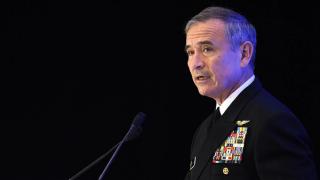Anzac Day morning gave Australians yet another taste of the dysfunction inside the Trump administration. In a remarkable last-minute change, Admiral Harry Harris, Donald Trump’s nominee as US ambassador to Australia, instead was reassigned to South Korea.
The decision was not intended to be a slight against Australia. Secretary of state-designate Mike Pompeo made the switch to ensure a high-calibre ambassador would be installed quickly in Seoul. Given the high-stakes denuclearisation talks under way between the US and North Korea, this is an important objective.
It is hard to escape the perception that the Trump administration is short-changing one ally to satisfy its needs with another. Australia has been without a US ambassador for more than 18 months since John Berry departed.
But it is hard to escape the perception that the Trump administration is short-changing one ally to satisfy its needs with another. Australia has been without a US ambassador for more than 18 months since John Berry departed. It now looks likely to be at least two years before one arrives, a prolonged and incongruous vacancy given the intimacy of the relationship.
It also is hard not to be alarmed about the way this decision was made. All reports point to the fact Pompeo, with the President’s support, changed the nomination at lightening speed with almost zero consultation across the foreign policy and national security elements of the administration.
This was a captain’s call made hours before Harris’s confirmation hearing before the Senate Foreign Relations Committee and hastily communicated to the Australian government. This flip-flop will play into a wider narrative that Trump does not take seriously the interests or concerns of US allies. It will be seen as a sign of Trump’s transactionalism and changeability on allies, placed in the same category as his imposition of tariffs on key US partners, criticism of NATO members and heated phone call with Malcolm Turnbull last year.
This flip-flop be seen as a sign of Trump’s transactionalism and changeability on allies, placed in the same category as his imposition of tariffs on key US partners, criticism of NATO members and heated phone call with Malcolm Turnbull last year.
A better interpretation of Harris’s reassignment, though, is what it reveals about the administration’s ongoing lack of coherence on US strategy in Asia. Statements such as the US National Security Strategy and National Defence Strategy argue that great power rivalry has returned to the Indo-Pacific.
These documents identify China as a strategic challenger to Asia’s rules-based order and outline a case for peacetime competition across multiple domains — from strengthening defence capabilities and combating political interference, to securing trade and investment flows, and maintaining an edge on technologies such as quantum computing, artificial intelligence and cyber. But when it comes to delivering on this strategy in a regional context, the Trump team has been stalling. Effective strategic policy in any of these arenas requires the input and commitment of US allies in Asia. This, in turn, depends on the administration’s ability to work through differences and concerns among regional allies — assuaging their fears that US policy won’t be erratic, overly confrontational with China, or punitive towards allies on bilateral trade issues.
Harris’s appointment to Australia was seen as a step in the right direction to deliver on this process. He is a highly competent commander of US Pacific Command, and his knowledge of the region’s security challenges and political personalities, and his leadership on issues such as the US-Australia-Japan-India “quad”, made him a unique fit for the Australian ambassadorship.
Pompeo’s hard-headed calculus was probably just this: that Australia’s relationship with the Trump administration can withstand the hurt from snatching Harris away.
Coupled with his ability to balance the need for strategic co-ordination with diplomatic savvy, Harris was regarded across the Indo-Pacific as the right person in the right place at the right time for the job.
Instead, his chaotic reassignment to the Korean peninsula confirms many of the fears of America’s allies and partners. It signals that the administration is not being strategic about its Indo-Pacific vision. Put simply, deploying the best candidate for the Australia job to Seoul prioritises the urgent — North Korea — over the strategically important, the need to work with close regional partners in a time of mounting uncertainty.
This does not mean that permanent damage is done to our ties with Washington. As former FBI director James Comey told ABC 7.30’s Leigh Sales last week, the US-Australia relationship is so deep that no president can single-handedly ruin it. Pompeo’s hard-headed calculus was probably just this: that Australia’s relationship with the Trump administration can withstand the hurt from snatching Harris away.
But many still will be burned by this decision. Australian leaders on both sides of politics have welcomed Harris’s nomination. Australia’s embassy in Washington has done tremendous work to bolster our visibility with the administration. The Prime Minister has invested heavily in his relationship with Trump; and a lot of hard work has taken place between Australian officials and their US counterparts. For this to be repaid with another high-profile disappointment is galling. More damaging is the missed opportunity that comes with sending a key US architect of Indo-Pacific strategy to a post that will be confined to the North Korean issue. In a week when Canberra reminds the US of our “100 years of mateship” and security co-operation, basic lessons of alliance management and Asia policy should have been heeded better.







